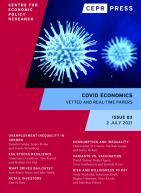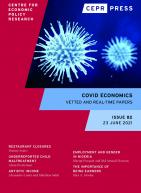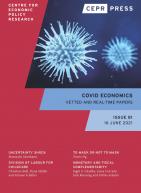
Non-Pharmaceutical Interventions (NPIs) have been for most countries the key policy instrument utilized to contain the impact of the COVID-19 pandemic. In this article, we conduct an empirical analysis of the impact of these policies on the virus’ transmission and death toll, for a panel of 152 countries, from the start of the pandemic through December 31, 2020. We find that lockdowns tend to significantly reduce the spread of the virus and the number of related deaths. We also show that this benign impact declines over time: after four months of strict lockdown, NPIs have a significantly weaker contribution in terms of their effect in reducing COVID-19 related fatalities. Part of the fading effect of quarantines could be attributed to an increasing non-compliance with mobility restrictions, as reflected in our estimates of a declining effect of lockdowns on measures of actual mobility. However, we additionally find that a reduction in de facto mobility also exhibits a diminishing effect on health outcomes, which suggests that lockdown fatigues may have introduced broader hurdles to containment policies.
Citation
Sartorio, L, E Yeyati and P Goldstein (2021), ‘Lockdown fatigue: The diminishing effects of quarantines on the spread of COVID-19‘, COVID Economics 67, CEPR Press, Paris & London. https://cepr.org/publications/covid-economics-issue-67#392514_392943_390712
We show the recovery in consumer spending in the United Kingdom through the second half of 2020 is unevenly distributed across regions. We utilise Fable Data: a real-time source of consumption data that is a highly correlated, leading indicator of Bank of England and Office for National Statistics data. The UK's recovery is heavily weighted towards the “home counties†around outer London and the South. We observe a stark contrast between strong online spending growth while offline spending contracts. The strongest recovery in spending is seen in online spending in the “commuter belt†areas in outer London and the surrounding localities and also in areas of high second home ownership, where working from home (including working from second homes) has significantly displaced the location of spending. Year-on-year spending growth in November 2020 in localities facing the UK's new tighter “Tier 3†restrictions (mostly the midlands and northern areas) was 38.4% lower compared with areas facing the less restrictive “Tier 2†(mostly London and the South). These patterns had been further exacerbated during November 2020 when a second national lockdown was imposed. To prevent such COVID-19-driven regional inequalities from becoming persistent we propose governments introduce temporary, regionally-targeted interventions in 2021. The availability of real-time, regional data enables policymakers to efficiently decide when, where and how to implement such regional interventions and to be able to rapidly evaluate their effectiveness to consider whether to expand, modify or remove them.
Citation
Stewart, N, E Quispe-Torreblanca, F Gunzinger, B Guttman-Kenney and J Gathergood (2021), ‘A Levelling Down and the COVID-19 Lockdowns: Uneven Regional Recovery in UK Consumer Spending‘, COVID Economics 67, CEPR Press, Paris & London. https://cepr.org/publications/covid-economics-issue-67#392514_392943_390713
We propose a model of how multiple societies respond to a common crisis. A government faces a “damned-either-way†policy-making dilemma: aggressive intervention contains the crisis, but the resulting good outcome makes people skeptical of the costly response; light intervention worsens the crisis and causes the government to be faulted for not doing enough. This dilemma can be mitigated for the society that encounters the crisis first if another society faces it afterward. Our model predicts that the later society does not necessarily perform better despite having more information, while the earlier society might benefit from a dynamic counterfactual effect.
Citation
Zhou, J and F Li (2021), ‘A Model of Crisis Management‘, COVID Economics 67, CEPR Press, Paris & London. https://cepr.org/publications/covid-economics-issue-67#392514_392943_390714
This study analyzes the benefits of statewide policy intervention in reducing COVID-19 deaths and the costs of that intervention in lost jobs and lower real gross state product (RGSP). Policy interventions are measured by the Oxford stringency index which places a daily numerical value on the level of a state’s policy intervention. Empirical evidence is provided that shows policy interventions have reduced COVID-19 deaths in the U.S. by 358,000 lives in 2020.  On the cost side, it was found that policy intervention resulted in a loss of 7.3 million jobs and a decline of $410 billion in RGSP. The study concludes by integrating the findings related to the benefits and costs of policy interventions to the economic cost per life saved for every state, as well as an estimate of the national average cost per life of $1.1 million. That figure is compared to an age-adjusted value of statistical life (VSL) calculated in the study of $4.2 million for COVID-19 fatalities.
Citation
Doti, J (2021), ‘Benefit-Cost Analysis of COVID-19 Policy Intervention at the State and National Level‘, COVID Economics 67, CEPR Press, Paris & London. https://cepr.org/publications/covid-economics-issue-67#392514_392943_390715
This paper estimates the benefits and costs of state suppression policies to “bend the curve†during the initial outbreak of COVID-19 in the United States. We employ a value-of-production approach that values benefits and costs in terms of additions or subtractions to total production. Relative to a baseline in which only the infected and at-risk populations mitigate the spread of coronavirus, we estimate that total benefits of suppression policies are between $605.9 billion and $841.1 billion from early March 2020 to August 1, 2020. Relative to private mitigation, the costs of suppression policies are estimated to be between $214.2 billion and $331.5 billion. The cost estimate is based on the duration of nonessential business closures and stay-at-home orders, which were enforced between 42 and 65 days. Our results indicate that the net benefits of suppression policies to slow the spread of COVID-19 are positive and may be substantial.
Citation
Kotrous, M and J Broughel (2021), ‘The Benefits of Coronavirus Suppression: A Cost-Benefit Analysis of the Response to the First Wave of COVID-19 in the United States‘, COVID Economics 67, CEPR Press, Paris & London. https://cepr.org/publications/covid-economics-issue-67#392514_392943_390716
We examine how the lives of adolescents in Low- and Middle- Income countries have been affected by the COVID-19 pandemic and related economic downturn using data from a large-scale phone survey conducted in four countries as a part of Young Lives, a 20-year longitudinal study.  The phone survey asked detailed information about the COVID-19 pandemic experiences as well as collecting welfare indicators that are comparable across rounds.  This allows a unique opportunity to compare a cohort of young people born around the turn of the Millennium (Younger Cohort) with an Older Cohort born in 1994, measured at the same age but seven years previously; both cohorts have been surveyed by the project since 2002. We find that relative gains in multidimensional well-being of the Younger Cohort found in survey rounds up to 2016 had largely disappeared in 2020. The significant (absolute and relative) downturn in self-reported wellbeing and economic circumstances is apparent in India, Ethiopia, and Peru, though not in Vietnam, the country which has had the most success at controlling the virus. However, educational enrolment has been affected in all countries. We suggest that the consequences of education dropout and links to potential mental health issues may mean the effects are long lasting in the absence of interventions to support young people’s wellbeing and livelihoods
Citation
Scott, D, A Sánchez, R Freund, C Porter and M Favara (2021), ‘Young Lives, interrupted: Short-term Effects of the COVID-19 Pandemic on Adolescents in Low- and Middle-Income Countries‘, COVID Economics 67, CEPR Press, Paris & London. https://cepr.org/publications/covid-economics-issue-67#392514_392943_390717
Despite the fact that the current covid-19 pandemic was neither the first nor the last disease to threaten a pandemic, only recently have studies incorporated epidemiology into macroeconomic theory. In our paper, we use a dynamic stochastic general equilibrium (DSGE) model with a financial sector to study the economic impacts of epidemics and the potential for unconventional monetary policy to remedy those effects. By coupling a macroeconomic model to a traditional epidemiological model, we are able to evaluate the pathways by which an epidemic affects a national economy. We find that no unconventional monetary policy can completely remove the negative effects of an epidemic crisis, save perhaps an exogenous increase in the shares of claims coming from the Central Bank (“epi loansâ€). To the best of our knowledge, our paper is the first to incorporate disease dynamics into a DSGE-SIR model with a financial.
Citation
Damette, O, D Shanafelt and V Acurio Vásconez (2021), ‘Macroepidemics and unconventional monetary policy: Coupling macroeconomics and epidemiology in a financial DSGE-SIR framework‘, COVID Economics 67, CEPR Press, Paris & London. https://cepr.org/publications/covid-economics-issue-67#392514_392943_390718


Covid Economics - Issue 82
- Restaurant Closures during the Pandemic: A Descriptive Analysis
- Underreporting Child Maltreatment during the Pandemic: Evidence from Colorado
- Covid-19 impact on Artistic Income
- COVID-19, Employment, and Gender: Evidence from Nigeria
- The Importance of Being Earners: Modelling the Implications of Changes to Welfare Contributions on Macroeconomic Recovery
